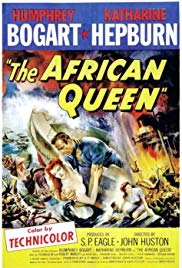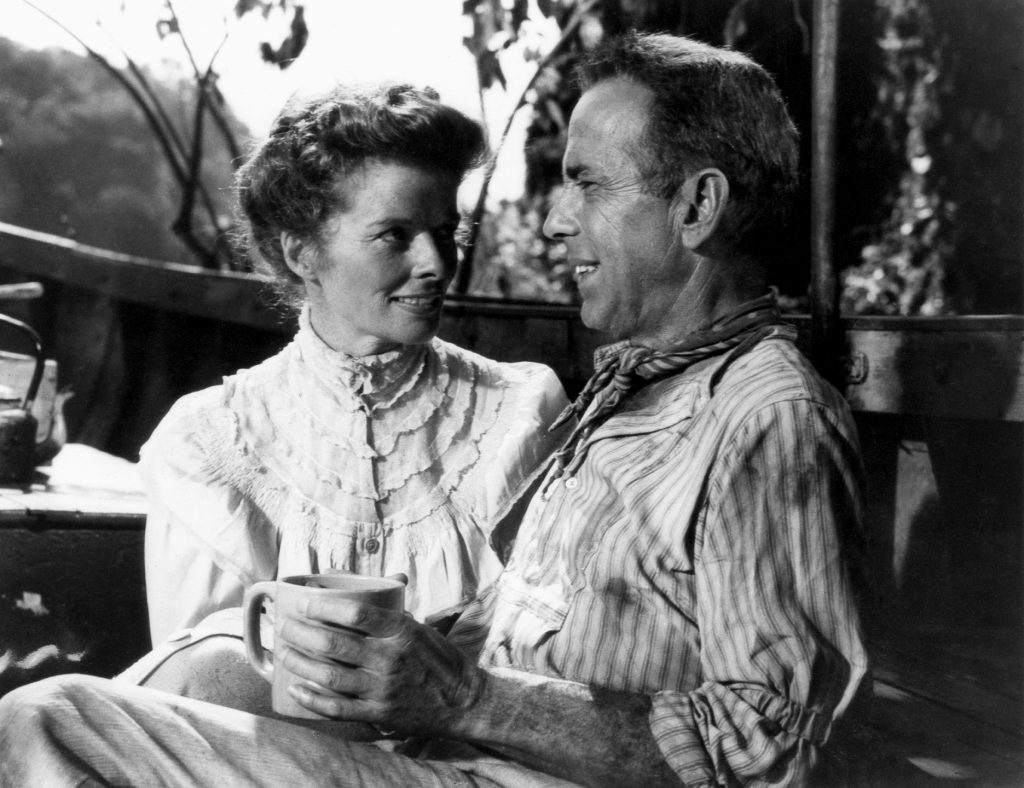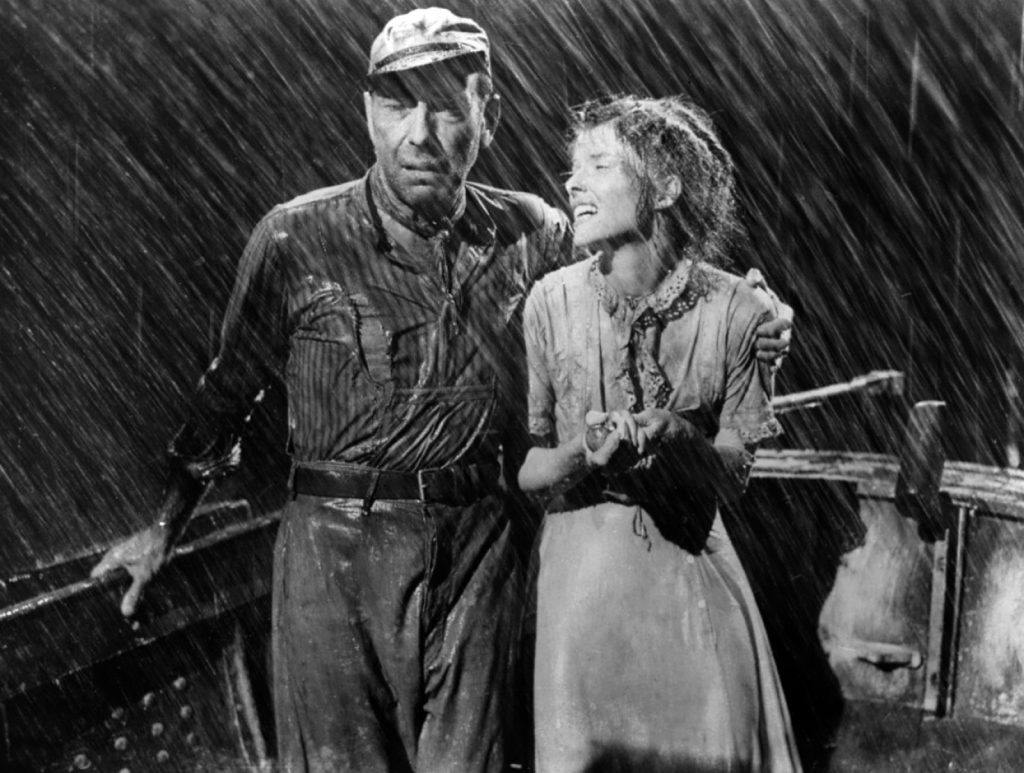THE AFRICAN QUEEN
SUBJECTS — Science-Technology; World/WWI & Africa;
SOCIAL-EMOTIONAL LEARNING — Romantic Relationships;
MORAL-ETHICAL EMPHASIS — Citizenship.
AGE: 10+; MPAA Rating — G;
Drama; 1951; 105 minutes; Color. Available from Amazon.com.
There is NO AI content on this website. All content on TeachWithMovies.org has been written by human beings.

SUBJECTS — Science-Technology; World/WWI & Africa;
SOCIAL-EMOTIONAL LEARNING — Romantic Relationships;
MORAL-ETHICAL EMPHASIS — Citizenship.
AGE: 10+; MPAA Rating — G;
Drama; 1951; 105 minutes; Color. Available from Amazon.com.
TWM offers the following movie worksheets to keep students’ minds on the film and to focus their attention on the lessons to be learned from the movie.
Film Study Worksheet for a Work of Historical Fiction;
Film Study Worksheet for ELA Classes; and
Worksheet for Cinematic and Theatrical Elements and Their Effects.
Teachers can modify the movie worksheets to fit the needs of each class. See also TWM’s Historical Fiction in Film Cross-Curricular Homework Project and Movies as Literature Homework Project.
The scene is Africa at the beginning of the First World War. A jack-of-all-trades boat operator of questionable reputation rescues a spinster missionary. Her brother, the only other missionary in the village, has died. Together the spinster and the boat operator undertake a hazardous but spectacular river journey and find their dream.
Selected Awards:
1951 Academy Awards: Best Actor (Bogart); 1951 Academy Award Nominations: Best Actress (Hepburn), Best Director (Huston), Best Screenplay. “The African Queen” is listed in the National Film Registry of the U.S. Library of Congress as a “culturally, historically or aesthetically significant” film. This film is ranked #17 on the American Film Institute’s List of the 100 Greatest American Movies of All Time (2006).
Featured Actors:
Humphrey Bogart, Katharine Hepburn, Robert Morley, Theodore Bikel, Peter Bull, Walter Gotell.
Director:
John Huston.
While the film has long been regarded as a classic romance, it can also be used to teach children about technological innovation, the steam engine, the history of WWI in Africa, and the lakes of Africa. Charlie, the boat operator, solves many engineering problems to get his skiff down the river. He performs more engineering marvels to sink the German warship. Rose, the spinster missionary, is a role model for a determined woman. Both Rose and Charlie change their lives and rise to the occasion. This movie examines the relationship between two very different people and how a common goal leads them to understand, and love, one another.
There is a brief scene of many black men fighting like children over a cigar dropped by the engineer. Alcohol abuse and smoking are shown with only a little negative comment.

The African Queen is best shown to high school students who have an interest in classic film. Tell your child to note the images of Africans presented in the film and ask them how they think African Americans would feel about these characterizations and how film may illustrate tribal people today.
Before World War I, German colonies in Africa included: South West Africa, Togoland, Cameroon and German East Africa. During the war the British, French and South Africans conquered the German possessions in Africa. The peace treaties at the end of the war gave the German colonies to the French and the British.
Leeches are worms that live by sucking the blood of larger animals. They are found on land and in the water. At the front of the leech is a small sucker that contains the mouth. A large sucker is on the back end. Leeches can grow to be eight inches long. They breathe through their skin. Their digestive systems can store food for several months. They can have up to four pairs of eyes. Leeches contain both the male and female reproductive organs but only the sperm of another leech can fertilize the egg. In Europe in the 18th and 19th centuries, leeches were used medicinally to drain off what was thought to be excess blood.

The steam engine changes the energy stored in coal, wood or oil into heat and then into mechanical energy. The heat is transferred to water, making steam.
There are two types of steam engines. In a piston and cylinder steam engine, the steam is allowed to enter an enclosed cylinder through an entry valve. One side of the cylinder consists of a sliding piston. As the steam enters the cylinder, the pressure increases and the piston is driven to the far side of the cylinder. When the cylinder is full, the entry valve is closed, and a release valve is opened. The steam then escapes, and the resulting vacuum draws the piston back toward the near side of the cylinder. The release valve is then closed and the entry valve opened again. As the steam enters, the piston responds by again moving toward the far side of the cylinder, and the process repeats itself. The second type of steam engine is the turbine in which a jet of steam is directed at the blades of a rotating wheel.
Steam engines rely on boilers to store steam at a pressure necessary to operate the engine. Boilers on steam engines have a safety valve that permits steam to escape when the pressure in the boiler threatens to cause an explosion. It is extremely dangerous to operate a steam engine with a defective safety valve. In the movie, the safety valve on the boiler is defective.
The steam engine was first perfected in England in 1769 by James Watt. The invention of the steam engine was a necessary precondition for the industrial revolution.
Africa has many large lakes, including Lake Victoria, Lake Tanganyika, Lake Nyasa and Lake Turkania. Various Christian denominations have sent Missionaries to Africa both to convert Africans to Christianity and to bring them medical care and modern farming methods.
1. See Discussion Questions for Use With any Film that is a Work of Fiction.
2. Why did the boat’s engine stop working when the hose broke and the pressure went to nothing?
3. How did the salt kill the leeches?
4. What was dangerous about the operation of the steam engine on the boat?
5. Remember the awful scene at the beginning of the film in which Africans are shown as infantile and silly? This was obviously a stereotyped portrayal meant to amuse a white audience. (Remember that the film was made in 1951.) This scene is highly offensive by today’s standards. Analyze the psychology behind this scene. What does it tell you about the attitudes of the type of people who would be amused by this scene?
1. Do you think that Rose would have had anything to do with Charlie had she had more experience with men? What does this tell us about romantic relationships?
Discussion Questions Relating to Ethical Issues will facilitate the use of this film to teach ethical principles and critical viewing. Additional questions are set out below.
(Do your share to make your school and community better; Cooperate; Stay informed; vote; Be a good neighbor; Obey laws and rules; Respect authority; Protect the environment)
1. Did Charlie and Rose have to risk their lives to torpedo the German warship? Why did they do it, and how does their action relate to the ethical value of citizenship?
2. Compare what Charlie and Rose did in sinking the German warship to the actions of the passengers of hijacked United Airlines Flight 93 who, on September 11, 2001, rushed the cockpit and caused the plane to crash short of the hijacker’s goal, which was probably the White House or the United States Capitol.
See the Learning Guide to Paths of Glory.
This Learning Guide was last updated on April 6, 2010.